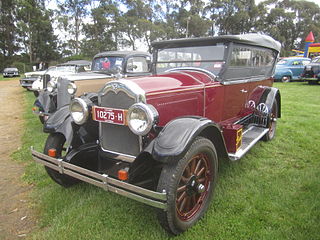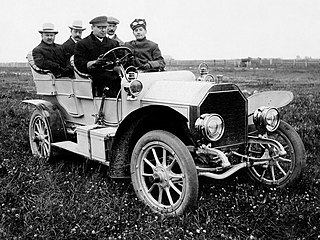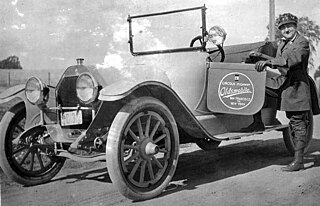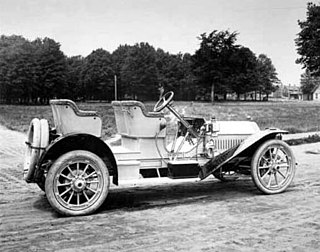
The Oldsmobile Series 70 is a full-size midrange automobile produced by Oldsmobile between the 1939 and 1950 model years. Oldsmobiles of this time period were in an unusual "middle" position in GM's hierarchy of automobile brands. Chevrolet and Pontiac were the budget priced models, while Buick and Cadillac were the luxury brands. GM would share their "A" body platforms between Chevrolet, Pontiac, and "B" body on Oldsmobile and Buick, while leaving Cadillac on the senior "C" platform. Oldsmobiles were then branded as "luxury level" Chevrolets and Pontiacs, while Oldsmobiles using the "B" platform were "budget priced" Buicks and Cadillacs.

Marquette was an American automobile manufacturer established by General Motors in 1909 after the purchase of the Rainier Motor Car Company. The Marquette Company did not last long and in 1912 GM announced the company would be closed.

The Buick Master Six, also denoted Series 40 and Series 50 based on the wheelbase used, was an automobile built by Buick from 1925 to 1928 and shared the GM B platform with the Oldsmobile Model 30. Previously, the company manufactured the Buick Six that used the overhead valve six-cylinder 242 cu in (4.0 L) engine in their high-end cars, and the Buick Four for smaller, less-expensive cars. After 1924, they dropped the four-cylinder engine and designed a small six, which they called the Buick Standard Six, to replace that end of the market. They coined the name "Master Six" for the high-end cars, now powered by the 255 cu in (4.2 L) engine released the year before. The yearly changes were a result of a new business philosophy called planned obsolescence.

The Chevrolet Series AC International is an American vehicle manufactured by Chevrolet in 1929 to replace the 1928 Series AB National. In all, 1,328,605 Series ACs were manufactured in a range of ten body styles, with 73,918 from Oshawa. The Series AC was distinguished from the AB by the introduction of a new six-cylinder engine, the first Chevrolet with a six-cylinder since the 1915 Chevrolet Series C Classic Six. Advertised as "A Six for the price of a Four", it was only $10 more than the outgoing four-cylinder Series AB. To simplify production operations, each factory was designated one body style for national consumption and shipped by railroad to major American cities. The serial number of origin was relocated to the right body sill underneath the rubber floormat except for the roadster and phaeton, which were inscribed on the right side of seat frame. Prices listed started at US$525 for the roadster or phaeton to US$725 for the Landau Convertible.

The Buick 4 was a series of passenger cars produced by the Buick Division of GM from 1909 through 1918, and was available as a touring car, phaeton or roadster. It was available with the Buick Model B as a larger alternative offering a larger engine and better durability. It became the junior sedan in 1914 when the Buick Six was introduced.

The Oldsmobile Model 30, which continued to be known as the Oldsmobile Six, was built from the 1923 through 1927. Each year it was built, it was given the suffix 30-A, 30-B, 30-C, 30-D and 30-E for the last year of production, all having been manufactured in Lansing, Michigan. General Motors used the GM A platform, shared with the Buick Standard Six and the Oakland Six, and the yearly changes were the result of a new business philosophy called planned obsolescence. The Model 30 was Oldsmobile mid-level product and introduced the flathead Oldsmobile straight-6 engine, while the Oldsmobile Model 43 with a four-cylinder engine remained the entry level product. When the top level Oldsmobile Light Eight, with the flathead Oldsmobile V8 engine was cancelled in 1923, the Oldsmobile Six became the top level vehicle. It replaced the Oldsmobile Model 37 introduced in 1917, and was replaced by the Oldsmobile F-Series introduced in 1928. In 5 years, 236,474 cars were built. The growing popularity of GM's brands, like Oldsmobile, contributed to becoming the largest automobile manufacturer when sales overtook the Ford Motor Company during this time period. Coachwork for the various bodystyles were supplied by Fisher Body of Detroit, MI, and starting with the 1923 model year, all GM products adopted a shared appearance, with brand specific unique appearance features. The retail price had dropped considerably from previous years due to the popularity and affordability of the Ford Model T, with the top level sedan at US$1,095.

The Model S was the first four-seat passenger car produced by Oldsmobile in 1906, offered as a larger alternative to the Model R Curved Dash runabout that appeared in 1901. The advertised price was $2,250. It was Oldsmobile's first four cylinder car and took the top level marketing position above the Model L and the entry-level Model R. It was one of the last independently developed products before they joined General Motors in 1908, and competed against Buick, Ford and other automakers at the time. It was built at the Oldsmobile factory in Detroit and developed by Frederick and Angus Smith, whose father Samuel L. Smith was the primary investor, and R. E. Olds had left the company due to an argument with Oldsmobile Board of Directors.
The Model 42 was an entry-level four seat passenger car produced by GM's Oldsmobile Division in 1914. It was offered as a replacement to the Oldsmobile Curved Dash runabout when it was discontinued in 1908, and was the junior platform to the Oldsmobile Six introduced in 1913. GM had acquired Elmore Manufacturing Company, Oldsmobile and Oakland Motor Car Company in 1908 and Cartercar and Rainier Motor Car Company in 1909 as their entry-level models, and Oldsmobile products were being repositioned in their new hierarchy as GM began to consolidate operations after William Durant had left.

The Model 43 was an entry-level four seat passenger car produced by GM's Oldsmobile Division in 1915 and 1916, then again in 1921 and 1922. It replaced the Model 42 also known as the "Baby Olds", while the most significant improvement was a longer wheelbase shared with the Buick Series C. Until GM assumed control of Chevrolet in 1917, the previous Model 42 and the Model 43 were GM's entry-level cars which led to the interrupted production of the Model 43 as Oldsmobile was promoted as a higher content product. It was also known as the "Oldsmobile Four" and competed with the Chevrolet Series H as an entry-level model until GM bought Chevrolet. It was the junior level product to the upscale Oldsmobile Light Eight. It was Oldsmobile's last four-cylinder car until 1977 with the Oldsmobile Starfire.

The Model M was a four-seat passenger car produced by Oldsmobile in 1908, offered as a mid-range alternative to the Model R Curved Dash runabout that appeared in 1901, replacing the Model A. It was the junior sedan to the first six-cylinder sedan called the Oldsmobile Model Z also introduced in 1908, but was larger than the Oldsmobile Model X.

The Model D was a four-seat passenger car produced by General Motors under the Oldsmobile brand in 1909, replacing the Model M. It was the last car engineered by Oldsmobile before it became a division of GM and began sharing a platform with Buick.

The Oldsmobile Six, also known as the Model 53, 54 and 55 (1913-1915) then a brief cancellation until it reappeared as the Model 37, 37A and 37B (1917-1921) was a top level sedan along with the Oldsmobile Series 40 junior vehicle produced by GM's Oldsmobile Division and was manufactured at Lansing Car Assembly in Lansing, Michigan. It replaced the Series 28 also known as the "Oldsmobile Autocrat" and was replaced by the Oldsmobile Model 30 in 1927, and shared wheelbases with the Buick Six. It continued to use the T-head engine for two years. The various bodystyles were supplied by Fisher Body of Detroit, MI. It competed with the Chevrolet Series C Classic Six as Chevrolet was an independent company before becoming a division in 1917. Oldsmobile also shared technology with GMC for commercial and industrial products.
The Oldsmobile Series 28, also known as the Autocrat, was a mid-level four seat passenger car produced by GM's Oldsmobile Division for 1911 and 1912. It was based on the top-level Oldsmobile Limited while using a four-cylinder engine, and was manufactured in Lansing, Michigan.

The Oldsmobile F-Series was a pre-WWII passenger car built from the 1928 through 1938 model years. The first generation continued the tradition of adding a series number for each model year; F-28, F-29, F-30 and F-31. The second generation, signified by a completely new bodystyle appearance was built from 1932 through 1938, all having been manufactured in Lansing, Michigan. 1926 saw the introduction of GM's most recognized business model, the use of common platforms shared amongst the brands, and Oldsmobile and Buick shared the GM B platform. The F-Series was shared with the Buick Master Six and was also known as the Oldsmobile Six which was introduced as a name earlier in 1913.

The Oldsmobile L-Series, or the Oldsmobile 8, was built from the 1932 through 1938. Oldsmobile hadn't offered a full-sized luxury flagship since the cancellation of the Oldsmobile Light Eight in 1923, and the Viking upscale companion brand to Oldsmobile didn't sell very well, being cancelled after two years. The 1933 model introduced a completely new body style influenced by the "streamlined" appearance, and it was shared with all GM brands due to GM's Art and Color Studio headed by Harley Earl. The appearance showed influences of Chrysler and Lincoln-Zephyr vehicles, and all Oldsmobiles were manufactured in Lansing, Michigan. Due to the popularity of the Oldsmobile F-Series, Oldsmobile recognized an opportunity to sell a similar sized alternative to the Buick Super, the Cadillac Series 355, and the "junior" companion brand LaSalle a platform the L-Series shared on the GM C platform. It was replaced by the Oldsmobile Series 90 introduced in 1938, and it was exported to Japan as a knock down kit and assembled at Osaka Assembly in Osaka, Japan.

The Oldsmobile Light Eight was an automobile produced by the Oldsmobile Division of General Motors in roadster, two-door coupe, four-door sedan from between 1916 and 1923. It was powered by a sidevalve V8 engine, the maker's first, and shared with the 1916 Oakland Model 50.

The Oldsmobile Limited was a top-level passenger car produced by GM's Oldsmobile Division in 1910, offered as an upgraded replacement to the Oldsmobile Model Z when it was discontinued in 1909. The Oldsmobile Limited was very large and expensive in comparison to vehicles offered by competitors, and was manufactured in Lansing, Michigan. It was the senior model to the mid-level Oldsmobile Autocrat of which it shared much of its technology while the Autocrat was smaller, and was replaced by the Oldsmobile Light Eight. It was also much larger than GM's lop level brand, the Cadillac Model Thirty which only had a four cylinder engine, and the Buick Model 10 which made the Limited the most expensive vehicle GM offered at the time.

The Oldsmobile Model Z was the company's first top-level passenger car produced under the Oldsmobile brand before they became a division of General Motors in 1908. The Model Z was created and engineered after Mr. Olds left the company but before they became a division, the same year the car was introduced. It was the senior model to the mid-level Oldsmobile Model M, and the entry-level, Buick engineered Oldsmobile Model 20. It was upgraded to become the Oldsmobile Limited.

The Model X was a four-seat passenger car produced by Oldsmobile in 1908, offered as an entry-level alternative to the Model D that appeared in 1901, replacing the Model M. It was the junior companion to the first six-cylinder sedan called the Oldsmobile Model Z also introduced in 1908, and shared most of its technology with the Model M.

The Buick Six was a top level automobile produced by GM's Buick Division which was first introduced in 1914, and was the senior vehicle to the Buick Series B Four. It was an all new platform which was shared with the Oldsmobile Six and was the first Buick to implement a steering wheel on the left side, and electric starter provided by Delco Remy along with an electric lighting system and electric Klaxon horn. The gearshift and emergency brake were relocated to a central position inside the vehicle, an approach used on all GM products for 1914. It continued to use the patented overhead valve engine implemented by Walter Lorenzo Marr while the cylinder head was not removable until later developments. The engine displacement was 331 cu in (5.4 L) and the wheelbase was 130 in (3,302 mm). The first year Buick Six was only offered as a touring sedan for US$1,985.



















